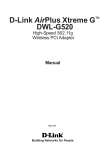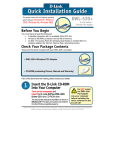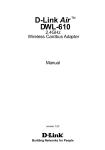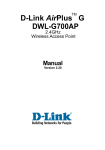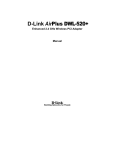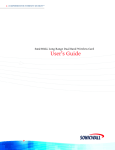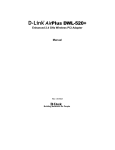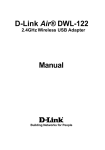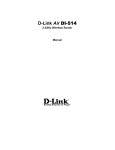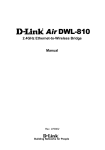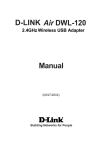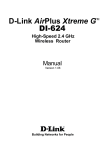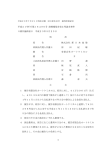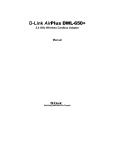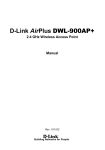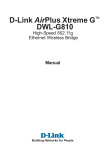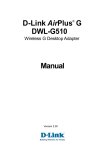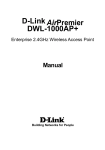Download D-Link Air DWL-520 Installation guide
Transcript
D-Link Air™ DWL-520 2.4GHz/802.11b Wireless PCI Adapter Manual version E1 Building Networks for People Contents Package Contents ................................................................................ 3 Introduction ........................................................................................... 4 Wireless Basics .................................................................................... 6 Getting Started ..................................................................................... 8 Using the Configuration Utility .............................................................11 Networking Basics .............................................................................. 24 Troubleshooting .................................................................................. 37 Technical Specifications ..................................................................... 42 Contacting Technical Support ............................................................. 44 Warranty and Registration .................................................................. 45 2 Package Contents Contents of Package: D-Link Air DWL-520 2.4 GHz Wireless PCI Adapter Manual and Drivers on CD Quick Installation Guide If any of the above items are missing, please contact your reseller. System Requirements: A computer or laptop with an available 32-bit PCI slot Windows XP/2000/Me/98SE At least 32 MB of memory and a 300 MHz processor An 802.11b Access Point (e.g., DWL-900AP+) for Infrastructure mode, or an 802.11b wireless adapter for Ad-Hoc mode (e.g., DWL-650.) This manual applies specifically to the DWL-520 revision E1. Please refer to earlier versions of this manual if you have a previous version of the DWL-520. 3 Introduction The D-Link Air DWL-520 Wireless PCI Adapter is an 802.11b wireless adapter that supports speeds up to 11Mbps* when used with a desktop computer. The DWL-520 is compatible with existing 802.11b devices such as the D-Link Air and AirPlus family of products including the DWL-650 and DWL-650+ Wireless Cardbus Adapters, the DI-514 and the DI-614+ Wireless Routers, DWL-700AP and DWL-900AP+ Wireless Access Points and the DWL-122 Wireless USB Adapter. The DWL-520 is an ideal way to connect your desktop computer to a Wireless Local Area Network (WLAN). After completing the steps outlined in the Quick Installation Guide (included in the package) you will have the ability to share information and resources, such as files and printers, and enjoy the freedom that wireless networking delivers. The DWL-520 has the newest, strongest, most advanced security features available today. When used with other 802.11 WPA (Wi-Fi Protected Access) and 802.1x compatible products in a network with a RADIUS server, the security features include: WPA: Wi-Fi Protected Access which authorizes and identifies users based on a secret key that changes automatically at a regular interval. WPA uses TKIP (Temporal Key Integrity Protocol) to change the temporal key every 10,000 packets (a packet is a kind of message transmitted over a network.) This insures much greater security than the standard WEP security. (By contrast, the older WEP encryption required the keys to be changed manually.) 802.1x: Authentication which is a first line of defense against intrusion. In the Authentication process the Authentication Server* verifies the identity of the client attempting to connect to the network. Unfamiliar clients would be denied access. For home users that will not incorporate a RADIUS server in their network, the security for the DWL-520, used in conjunction with other WPA-compatible 802.11 products, will still be much stronger than ever before. Utilizing the Pre Shared Key mode of WPA, the DWL-520 will obtain a new security key every time it connects to the 802.11 network. You only need to input your encryption information once in the configuration menu. No longer will you have to manually input a new WEP key frequently to ensure security. With the DWL-520, you will automatically receive a new key every time you connect, vastly increasing the safety of your communication. * Not all servers can provide Authentication. *”Maximum wireless signal rate based on IEEE Standard 802.11b specifications. Actual data throughput will vary. Network conditions and environmental factors, including volume of network traffic, building materials and construction, and network overhead lower actual data throughput rate.” 4 Features & Benefits Provides a simple and inexpensive way to connect your desktop computer to a wireless network at home, at the office, or in public places Fully compliant with the 802.11b standard and interoperable with all existing 802.11b-compliant devices Quick and Easy Installation- The DWL-520 installs quickly and easily into a standard PCI 2.2 slot in a desktop computer. By following the simple steps outlined in the Quick Installation Guide, you can connect to an available wireless network in a matter of seconds High Performance 32-bit PCI - The high capacity PCI interface utilized by the DWL-520 ensures optimal performance in transmitting a wireless signal within the desktop computer. By utilizing a standard PCI 2.2 interface, the DWL-520 ensures a wide range of compatibility with motherboards used by PC manufacturers Provides high-speed wireless connection up to 11Mbps* Operates in the 2.4GHz frequency range Maximum reliability, throughput and connectivity with automatic data rate switching Supports infrastructure networks via an access point and peer-to-peer communication in ad-hoc mode User-friendly configuration and diagnostic utilities Provides a measure of security for the information transmitted over a wireless network with high data encryption at 64 or 128-bit WEP Stronger Security than ever before with WPA - Wi-Fi Protected Access authorizes and identifies users based on a secret key that changes automatically at a regular interval, for example: TKIP (Temporal Key Integrity Protocol), in conjunction with a RADIUS server, changes the temporal key every 10,000 packets, ensuring greater security Pre Shared Key mode means that the home user, without a RADIUS server, will obtain a new security key every time he or she connects to the network, vastly improving the safety of communications on the network Extra Protection - 802.1x Authentication in conjunction with the RADIUS server verifies the identity of wireless clients wishing to gain access to the WLAN *”Maximum wireless signal rate based on IEEE Standard 802.11b specifications. Actual data throughput will vary. Network conditions and environmental factors, including volume of network traffic, building materials and construction, and network overhead lower actual data throughput rate.” 5 Wireless Basics D-Link wireless products are based on industry standards to provide easy-to-use and compatible high-speed wireless connectivity within your home, business or public access wireless networks. D-Link wireless products will allow you access to the data you want, when and where you want it. You will be able to enjoy the freedom that wireless networking brings. A Wireless Local Area Network (WLAN) is a cellular computer network that transmits and receives data with radio signals instead of wires. WLANs are used increasingly in both home and office environments, and public areas such as airports, coffee shops and universities. Innovative ways to utilize WLAN technology are helping people to work and communicate more efficiently. Increased mobility and the absence of cabling and other fixed infrastructure have proven to be beneficial for many users. Wireless users can use the same applications they use on a wired network. Wireless adapter cards used on laptop and desktop systems support the same protocols as Ethernet adapter cards. People use WLAN technology for many different purposes: Mobility - Productivity increases when people have access to data in any location within the operating range of the WLAN. Management decisions based on real-time information can significantly improve worker efficiency. Low Implementation Costs – WLANs are easy to set up, manage, change and relocate. Networks that frequently change can benefit from WLANs ease of implementation. WLANs can operate in locations where installation of wiring may be impractical. Installation and Network Expansion - Installing a WLAN system can be fast and easy and can eliminate the need to pull cable through walls and ceilings. Wireless technology allows the network to go where wires cannot go - even outside the home or office. Scalability – WLANs can be configured in a variety of ways to meet the needs of specific applications and installations. Configurations are easily changed and range from peer-to-peer networks suitable for a small number of users to larger infrastructure networks to accommodate hundreds or thousands of users, depending on the number of wireless devices deployed. Inexpensive Solution - Wireless network devices are as competitively priced as conventional Ethernet network devices. 6 Wireless Basics (continued) The DWL-520 is compatible with 802.11b wireless products, which include: D-Link Air DWL-650,D-Link AirPlus DWL-650+ 2.4GHz Wireless Cardbus Adapter used with laptop computers D-Link AirPlus DWL-520+ 2.4GHz Wireless PCI cards used with desktop computers D-Link Air DWL-700AP, D-Link AirPlus DWL-900AP+ 2.4GHz Wireless Access Points D-Link Air DI-514, D-Link AirPlus DI-614+, DI-714P+ 2.4GHz Wireless Routers Standards-Based Technology Based on the IEEE 802.11b standard, the DWL-520 is also interoperable with existing compatible 2.4GHz wireless technology with data transfer speeds of up to 11Mbps. Installation Considerations The D-Link Air DWL-520 lets you access your network using a wireless connection from virtually anywhere within its operating range. Keep in mind, however, that the number, thickness and location of walls, ceilings, or other objects that the wireless signals must pass through, may limit the range. Typical ranges vary depending on the types of materials and background RF (radio frequency) noise in your home or business. The key to maximizing wireless range is to follow these basic guidelines: 1 Keep the number of walls and ceilings between the DWL-520 and other network devices to a minimum - each wall or ceiling can reduce your D-Link Air Wireless product’s range from 3-90 feet (1-30 meters.) Position your devices so that the number of walls or ceilings is minimized. 2 Be aware of the direct line between network devices. A wall that is 1.5 feet thick (.5 meters), at a 45-degree angle appears to be almost 3 feet (1 meter) thick. At a 2-degree angle it looks over 42 feet (14 meters) thick! Position devices so that the signal will travel straight through a wall or ceiling (instead of at an angle) for better reception. 3 Building Materials can impede the wireless signal - a solid metal door or aluminum studs may have a negative effect on range. Try to position wireless devices and computers with wireless adapters so that the signal passes through drywall or open doorways and not other materials. 4 Keep your product away (at least 3-6 feet or 1-2 meters) from electrical devices or appliances that generate RF noise. 7 Getting Started With its default settings, the DWL-520, when activated, will connect with other D-Link Air products, right out of the box. There are basically two modes of networking: Infrastructure – using an Access Point or Router, such as the DI-514 or the DI-614+ Ad-Hoc – directly connecting to another computer, for peer-topeer communication, using wireless network adapters on each computer, such as two or more DWL-520 wireless network adapters On the following pages we will show you an example of an Infrastructure Network and an Ad-Hoc Network. An Infrastructure network contains an Access Point or Router. The Infrastructure Network example shown on the following page contains the following D-Link network devices (your existing network may be comprised of other devices): A wireless router - D-Link Air DI-514, D-Link AirPlus DI-614+ A laptop computer with a wireless adapter D-Link Air DWL-650 A desktop computer with a wireless adapter D-Link Air DWL-520 A Cable modem - D-Link DCM-201 LEDs LED stands for Light-Emitting Diode. Power: Solid green light indicates connection to the network Activity: Blinking green light indicates activity on the network 8 Getting Started (continued) Setting up a Wireless Infrastructure Network 2 1 3 7 4 6 5 Please remember that D-Link Air wireless devices are pre-configured to connect together, right out of the box, with their default settings. For a typical wireless setup at home (as shown above), please do the following: You will need broadband Internet access (a Cable or DSL-subscriber line into your home or office). Consult with your Cable or DSL provider for proper installation of the modem. Connect the Cable or DSL modem to your broadband router (see the Quick Installation Guide included with your router.) Install the D-Link Air DWL-520 wireless PCI adapter into an available PCI slot on your desktop computer. (See the Quick Installation Guide included with the DWL-520.) Install the D-Link Air DWL-650 wireless Cardbus adapter into a laptop computer. (See the Quick Installation Guide included with the DWL-650.) If you wish, you may connect a computer that is equipped with an Ethernet network adapter (such as a DFE-530TX+) to the router also. A RADIUS Server is optional. Connect a RADIUS Server to your network to use all the features of WPA. (Without a RADIUS Server you can still use the WPA Pre-Shared Key mode.) RADIUS Authentication can also be provided by another service provider over the Internet and remote to your network site. 9 Getting Started (continued) Setting up a Wireless Ad Hoc Network Desktop Install the DWL-520 into the desktop computer. (See the Quick Installation Guide included with the product for installation instructions.) Install the DWL-650 wireless Cardbus adapter into a laptop computer. (See the Quick Installation Guide included with the product.) Set the wireless configuration for the adapters to Ad-Hoc mode, set the adapters to the same channel, and assign an IP Address to each computer on the Ad-Hoc network. (See Box below) IP Address When assigning IP Addresses to the computers on the network, please remember that the IP Address for each computer must be in the same IP Address range as all the computers in the network, and the subnet mask must be exactly the same for all the computers in the network. For example: If the first computer is assigned an IP Address of 192.168.0.2 with a Subnet Mask of 255.255.255.0, then the second computer can be assigned an IP Address of 192.168.0.3 with a Subnet Mask of 255.255.255.0, etc. IMPORTANT: If computers or other devices are assigned the same IP Address, one or more of the devices may not be visible on the network. 10 Using the Configuration Utility D-Link Air DWL-520 uses the Configuration Utility as the management software. The utility provides the user an easy interface to change any settings related to the wireless adapter. After you have completed the installation of the DWL-520 (refer to the Quick Installation Guide that came with your purchase) whenever you start the computer, the Configuration Utility starts automatically and the system tray icon is loaded in the toolbar (see illustration below*.) Clicking on the utility icon will start the Configuration Utility. Another way to start the Configuration Utility is to click on Start>Programs>D-Link Air>D-Link Air Utility. If you are using Windows XP, you can use either the Zero Configuration Utility or the D-Link Configuration Utility. To use the D-Link Configuration Utility with XP, right-click on the Wireless network icon in the taskbar in the lower right-hand corner of your computer screen. In the window that appears, select View Available Wireless Networks and click the Advanced button. The screen at right will appear. Select the Wireless Networks tab. test1 test2 Uncheck the box in the properties window that enables windows configuration. After you have done this, you can then use the D-Link Configuration Utility with XP by clicking on the D-Link Configuration Utility icon. *Configuration Utility icon in the system tray If the icon does not display in the taskbar, then click on this icon on your desktop to open. 11 Using the Configuration Utility (continued) After clicking on the Configuration Utility icon, the Link Info screen will display the settings for the DWL-520: Status: Displays the MAC Address of the Access Point or Router to which the DWL-520 is associated Link Info SSID: The Service Set Identifier is the name assigned to the wireless network. The factory SSID setting is default. Frequency: 802.11b indicates that the DWL-520 is communicating in the 2.4GHz band. Wireless Mode: Either Infrastructure or Ad-Hoc will be displayed here. (Please see the Getting Started section in this manual for an explanation of these two modes.) Encryption: You can see if WEP (Wired Equivalent Privacy) is Enabled or Disabled here. Tx Rate: Tx Rate settings are automatically determined for an optimal speed up to a maximum of 11Mbps. Channel: The channel selection is automatically determined by the DWL-520. Signal Strength/Link Quality: Displays the Link Quality for the DWL-520 wireless connection to the Access Point. The Signal Strength represents the wireless signal between the Access Point and the DWL-520. The percentage coincides with the graphical bar. Packet Count: Displays the statistics of the data packets that are transmitted and received. Rescan Button: Rescans for the strongest signal in your environment and associates with that Access Point or Router. 12 Using the Configuration Utility (continued) SSID: Service Set Identifier is a name that identifies a wireless network. Access Points and wireless devices attempting to connect to a specific WLAN (Wireless Local Area Network) must use the same SSID. The default setting is default. Configuration Wireless Mode: Click on the pull-down menu; select from the following options: Infrastructure - connecting to the WLAN using an Access Point.(This is the default setting). Ad-Hoc – wireless mode used when connecting directly to a computer equipped with a wireless adapter in a peer-to-peer environment. IP Settings Data Encryption: Select Enabled or Disabled. Authentication: Choose one of the following modes: Open Authentication – the DWL-520 is visible to all devices on the network Shared Authentication – allows communication only with other devices with identical WEP settings Auto – will automatically adjust to the Authentication mode of the wireless Access Point or Router Key Length: Select the key length and either ASCII or hexadecimal format. Keys 1-4: Select the default key Hexadecimal digits consist of the numbers 0-9 and the letters A-F ASCII (American Standard Code for Information Interchange) is a code for representing English letters as numbers from 0-127 IP Settings: When you click IP Settings in the Configuration window, the pop-up screen above will appear. Configure the IP Settings in this window. Click Apply to save changes. 13 Using the Configuration Utility (continued) Ad-Hoc Channel: All devices in the Ad-Hoc network must be set to the same channel Advanced Profile IP Settings: You can Enable or Disable the IP Settings portion of your profile here. If you select Disable you will need to configure the IP Address information each time you connect to a network. If you select Enable you will maintain the same IP Address information each time you connect to a network. Power Mode: Launch Utility on Startup: Disable -this default setting consumes the most power Enable - this setting consumes the least power Select Enable or Disable Data Packet Parameter: Set the Fragmentation Threshold and the RTS Threshold. Please see below. Fragmentation Threshold: This value should remain at its default setting of 2432. If you experience a high packet error rate, you may slightly increase your Fragmentation Threshold within the value range of 256 to 2432. Setting the Fragmentation Threshold too low may result in poor performance. RTS Threshold: This value should remain at its default setting of 2432. If inconsistent data flow is a problem, only a minor modification should be made. Click Apply if you have made any changes 14 Using the Configuration Utility (continued) Available Network: The top section of the window displays the Available Networks. Scroll up and down the list and highlight the network to which you wish to connect. Click on the Connect button. Profile: In the lower half of the screen, you can manage the profiles that you have created for the wireless network at home, at the office and in public places. Scroll up and down and highlight the profile that you wish to configure. You can Add or Remove a profile, or configure the Properties of the profile in order to connect with an available network. Refresh: Click on Refresh to get the most updated list of available networks. Site Survey Configure: Highlight an existing network and click Configure; the configuration window on the next page will appear. Advanced: Highlight a network; click Advanced and the screen on the next page will appear. Add: Click Add and the screen on the next page will appear. Remove: Highlight a network profile; click Remove to remove a network from the profile list. Properties: Highlight a network profile; click Properties and the screen on the next page will appear. Connect: Highlight a network profile; click Connect to connect to that network. Rescan: Click Rescan to rescan and connect to the strongest signal. 15 Using the Configuration Utility (continued) Site Survey > Add Advanced In this window you can select the type of network connection. Click OK to save the changes. If you clicked on Add, you can configure, in this window, all the properties of a profile that you wish to add to the network. Configuration, Add or Properties If you clicked on Configuration or Properties you can configure, in this window, all the properties of a profile that already exists in the network. If you select WPA in the Authentication field, please see detailed instructions for configuring WPA on the following pages. If you choose to use the IEEE 802.1X feature, please see the detailed instructions on the following pages. Click OK to save the changes. 16 Using the Configuration Utility (continued) Site Survey > Configuration > 802.1X To use 802.1x and to configure its settings, please do the following: IEEE 802.1X Select Enabled. Click Authentication Config Advanced Security Settings Select the EAP Type you want to use. Configure the information needed for authenticating. Inner Authentication Protocol. For an explanation of the terms shown in this window please see the following pages. Trusted CA List. Click OK 17 Using the Configuration Utility (continued) 802.1x > Advanced Security Settings > EAP Types EAP Type Inner Authentication Protocol Information needed for Authenticating EAP-TLS Certificate User Name EAPMSCHAPv2 User Name Password Domain Name LEAP User Name Password EAP-TTLS PAP TTLS Identity User Name Password CHAP TTLS Identity User Name Password MSCHAP TTLS Identity User Name Password Domain Name MSCHAPv2 TTLS Identity User Name Password Domain Name 18 Using the Configuration Utility (continued) 802.1x > Advanced Security Settings > EAP Types (continued) EAP Type EAP-TTLS Inner Authentication Protocol EAP-MD5 TTLS Identity User Name Password EAPGeneric Token Card TTLS Identity User Name Password EAP-MSCHAPv2 EAP-MD5 PEAP Information needed for Authenticating EAP-MSCHAPv2 EAPGeneric Token Card TTLS Identity User Name Password Domain Name User Name Password User Name Password Domain Name User Name Password 802.1x > Advanced Security Settings > Definitions of Terms Validate Server Certificate: Check Validate Server Certificate to verify the identity of the authentication server based on its certificate when using EAP-TTLS, PEAP, and EAP-TLS. (This is checked by default.) Certain protocols, such as EAP-TTLS, PEAP, and EAP-TLS, allow you to verify the identity of the authentication server as the server verifies your identity. This is called mutual authentication. You can select trusted authentication server certificates using the Add button at the Trusted CA List (at the bottom of the Advanced Security Settings page). 19 Using the Configuration Utility (continued) 802.1x > Advanced Security Settings > Definitions of Terms (continued) Domain Name: Each server has a domain name that uniquely identifies it. That domain name is normally contained in the Subject CN field of the server certificate. A server domain name ends with the name of a larger administrative domain, to which the server belongs. TTLS Identity: EAP-TTLS has a unique feature that other protocols do not offer. Because it sets up an encrypted tunnel for your credentials, it is also able to pass your login name through that tunnel. That means that not only are your credentials secure from eavesdropping, but your identity is protected as well. Thus, with EAP-TTLS you have two identities: an inner one, and an outer one. The inner identity is your actual user name. Your outer identity can be completely anonymous. Set your outer identity in the TTLS Identity field. Trusted CA List: The Trusted CA List allows you to configure which authentication servers you trust for the purpose of logging you in to the network. Click Add at the Trusted CA List at the bottom of the Advanced Security Settings page. Select the Trusted CA that you want to add and click OK. 20 Using the Configuration Utility (continued) Authentication > WPA Select the available network to which you want to connect. Click Configure. Select WPA in the Authentication field. Click Authentication Config After you click Authentication Config, the Advanced Security Settings screen will appear. Complete the Advanced Security Settings configuration. Please see pages 17-20 of this manual to find out more about the Advanced Security Settings. 21 Using the Configuration Utility (continued) Authentication > WPA-PSK Select the available network to which you want to connect. Click Configure. WPA-PSK does not require a RADIUS Server in the network. Select WPA-PSK in the Authentication field. Click Authentication Config 22 Using the Configuration Utility (continued) Authentication > WPA-PSK (continued) Advanced Security Settings Enter the WPA Passphrass. Click OK. The configuration is done. About The About screen gives you the MAC address, Utility Version and the Driver Version of the DWL-520. 23 Networking Basics Using the Network Setup Wizard in Windows XP In this section you will learn how to establish a network at home or work, using Microsoft Windows XP. Note: Please refer to websites such as http://www.homenethelp.com and http://www.microsoft.com/windows2000 for information about networking computers using Windows 2000, ME or 98SE. Go to Start>Control Panel>Network Connections Select Set up a home or small office network When this screen appears, click Next. 24 Networking Basics (continued) Please follow all the instructions in this window: Click Next In the following window, select the best description of your computer. If your computer connects to the internet through a gateway/router, select the second option as shown. Click Next 25 Networking Basics (continued) Enter a Computer description and a Computer name (optional.) Click Next Enter a Workgroup name. All computers on your network should have the same Workgroup name. Click Next 26 Networking Basics (continued) Please wait while the Network Setup Wizard applies the changes. When the changes are complete, click Next. Please wait while the Network Setup Wizard configures the computer. This may take a few minutes. 27 Networking Basics (continued) In the window below, select the option that fits your needs. In this example, Create a Network Setup Disk has been selected. You will run this disk on each of the computers on your network. Click Next. Insert a disk into the Floppy Disk Drive, in this case drive A. 28 Networking Basics (continued) Please read the information under Here’s how in the screen below. After you complete the Network Setup Wizard you will use the Network Setup Disk to run the Network Setup Wizard once on each of the computers on your network. To continue click Next. 29 Networking Basics (continued) Please read the information on this screen, then click Finish to complete the Network Setup Wizard. The new settings will take effect when you restart the computer. Click Yes to restart the computer. You have completed configuring this computer. Next, you will need to run the Network Setup Disk on all the other computers on your network. After running the Network Setup Disk on all your computers, your new wireless network will be ready to use. 30 Networking Basics (continued) Naming your Computer To name your computer, please follow these directions:In Windows XP: Click Start (in the lower left corner of the screen) Right-click on My Computer Select Properties and click Select the Computer Name Tab in the System Properties window. You may enter a Computer Description if you wish; this field is optional. To rename the computer and join a domain, Click Change. 31 Networking Basics (continued) Naming your Computer In this window, enter the Computer name Select Workgroup and enter the name of the Workgroup All computers on your network must have the same Workgroup name. Click OK Checking the IP Address in Windows XP The wireless adapter-equipped computers in your network must be in the same IP Address range (see Getting Started in this manual for a definition of IP Address Range.) To check on the IP Address of the adapter, please do the following: Right-click on the Local Area Connection icon in the task bar Click on Status 32 Networking Basics (continued) Checking the IP Address in Windows XP This window will appear. Click the Support tab Click Close Assigning a Static IP Address in Windows XP/2000 Note: Residential Gateways/Broadband Routers will automatically assign IP Addresses to the computers on the network, using DHCP (Dynamic Host Configuration Protocol) technology. If you are using a DHCP-capable Gateway/Router you will not need to assign Static IP Addresses. If you are not using a DHCP capable Gateway/Router, or you need to assign a Static IP Address, please follow these instructions: Go to Start Double-click on Control Panel 33 Networking Basics (continued) Assigning a Static IP Address in Windows XP/2000 Double-click on Network Connections Right-click on Local Area Connections Double-click on Properties 34 Networking Basics (continued) Assigning a Static IP Address in Windows XP/2000 D-Link Air DWL-520 Wireless PCIAdapter Click on Internet Protocol (TCP/IP) Click Properties In the window below, select Use the following IP Address. Input your IP Address and subnet mask. (The IP Addresses on your network must be within the same range. For example, if one computer has an IP Address of 192.168.0.2, the other computers should have IP Addresses that are sequential, like 192.168.0.3 and 192.168.0.4. The subnet mask must be the same for all the computers on the network.) IP Address: e.g., 192.168.0.2 Subnet Mask: 255.255.255.0 Default Gateway: Enter the LAN IP Address of the wireless router. (D-Link wireless routers have a LAN IP Address of 192.168.0.1) Select Use the following DNS server address. Enter the LAN IP Address of the wireless router. (D-Link wireless routers have a LAN IP Address of 192.168.0.1) Click OK You have completed the assignment of a Static IP Address. (You do not need to assign a Static IP Address if you have a DHCP-capable Gateway/Router.) 35 Networking Basics (continued) Checking the Wireless Connection by Pinging in Windows XP and 2000* Go to Start > Run > type cmd. A window similar to this one will appear. Type ping xxx.xxx.xxx. xxx, where xxx is the IP Address of the Wireless Router or Access Point. A good wireless connection will show four replies from the Wireless Router or Acess Point, as shown. Checking the Wireless Connection by Pinging in Windows Me and 98* Go to Start > Run > type command. A window similar to this will appear. Type ping xxx.xxx. xxx.xxx where xxx is the IP Address of the Wireless Router or Access Point. A good wireless connection will show four replies from the wireless router or access point, as shown. *You may be pinging different IP Addresses than the ones pictured here, however the procedure for pinging remains the same.) 36 Troubleshooting This chapter provides solutions to problems that can occur during the installation and operation of the DWL-520. Read the following descriptions if you are having problems. (The examples below are illustrated in Windows XP. If you have another operating system, these solutions will still apply although the appearance on your computer screen may differ.) 1. Check that the drivers for the DWL-520 are installed properly. Go to Start > My Computer > Properties Select the Hardware Tab Click Device Manager 37 Troubleshooting (continued) Double-click on Network Adapters Right-click on D-Link Air DWL-520 Wireless PCI Adapter Select Properties to check that the drivers are installed properly Look under Device Status to check that the device is working properly Click OK 38 Troubleshooting (continued) 2. I cannot connect to the Access Point or the wireless router. Make sure that the SSID on the DWL-520 PCI adapter is exactly the same as the SSID on the Access Point or wireless router. Move the DWL-520 and Access Point or wireless router into the same room and then test the wireless connection. Disable all security settings. (WEP, MAC Address Control, AES) Refresh the DWL-520 Utility Turn off your Access Point and the computer with the DWL-520. Turn on the Access Point, and then turn on the computer with the DWL-520. 3. The DWL-520 Power and Link lights are not on. Check to see if the DWL-520 PCI adapter is firmly inserted into the PCI slot of your computer. 4. I forgot my Encryption key. Reset the Access Point to its factory default settings and restore the DWL520 Wireless PCI Adapter to the factory default settings. (The default settings are listed in the Using the Configuration Utility section in this manual.) 5. The computer does not recognize the DWL-520 PCI Adapter. Make sure that the DWL-520 Wireless PCI Adapter is properly seated in the computer’s PCI slot. If Windows does not detect the hardware upon insertion of the adapter, make sure to completely remove drivers that were previously loaded. To remove the drivers, do the following: 39 Troubleshooting (continued) A. Under Tools> select Folder Options…> select View > under Hidden files and folders > select Show hidden files and folders B. Uncheck Hide extension for known file types > click on Apply C. Search for the files DWL520.INF and DWL520.SYS. Remove these files from the INF and SYSTEM32 (DRIVERS) folders in the Windows directory. Note: Windows XP and Windows 2000 will rename .inf files that have not received WHQL certification into oem.inf files (e.g., oem1.inf.) 6. The computer with the DWL-520 installed is unable to connect to the wireless network and/or the Internet. Check that the LED indicators for the broadband modem are indicating normal activity. If not, there may be a problem with the broadband connection. Check that the LED indicators on the wireless router are functioning properly. If not, check that the AC power and Ethernet cables are firmly connected. Check that the IP Address, subnet mask, gateway, and DNS settings are correctly entered for the network In Infrastructure mode, make sure the same Service Set Identifier (SSID) is specified on the settings for the wireless clients and access points. The SSID factory default setting for the D-LinkAir and AirPlus products is default. (Double-click on the WLAN icon in the taskbar. The Link Info screen will display the SSID setting.) In Ad-Hoc mode, both wireless clients will need to have the same SSID. Please note that it might be necessary to set up one client to establish a BSS (Basic Service Set) and wait briefly before setting up other clients. This prevents several clients from trying to establish a BSS at the same time, which can result in multiple singular BSSs being established, rather than a single BSS with multiple clients associated to it. 40 Troubleshooting (continued) Check that the Network Connection for the wireless client is configured properly. Select AP (Infrastructure) when connecting to an access point and select Ad-Hoc mode when connecting without an access point. Doubleclick on the WLAN icon in the taskbar > click on Configuration to change the settings for the wireless adapter. If Security is enabled, make sure that the correct encryption keys are entered on both the DWL-520 and the access point. Double-click on the WLAN icon in the taskbar > click Encryption. Check to see that the key selected is set to the same key as other devices on the network. 7. How can I troubleshoot distance issues using the DWL-520. Move the DWL-520 and Access Point or wireless router into the same room and then test the wireless connection. Change the channel of the Access Point. Move devices within the line of sight 41 Technical Specifications Standards IEEE 802.11b Temperature Operating: 32ºF to 131ºF (0ºC to 55ºC) Storing: -4ºF to 167ºF (-20ºC to 75ºC) Humidity: Operating: 10% - 90%, non-condensing Storage: 5% - 95%, non-condensing Antenna Type: Single dipole antenna with reverse SMA connector Emissions: FCC part 15b Physical Dimensions: L = 6.10 inches (155mm) W = 5.51 inches (140mm) H = .90 inches (23mm) Interface: Weight: .20 lbs. (90g) Bus Type: PCI 2.2 PCI 32-bit Operating Voltage: SVDC +/- 5% Warranty: 1 Year System Requirements: Computer with an available PCI slot Windows XP/2000/Me/98SE At least 32MB of memory and a 300 MHz processor An 802.11b Access Point (e.g., DWL-900AP+) for Infrastructure mode; or an 802.11b wireless adapter (e.g., DWL-650) for Ad-Hoc mode. 42 Technical Specifications (continued) Data Rates: 1, 2, 5.5, 11Mbps* (with Automatic Fallback) Operating Channels: 1-11 United States (FCC) Encryption: Supports 64-bit or 128-bit WEP encryption Frequency Range: 2.4 – 2.497 GHz Media Access Control: CSMA/CA with ACK Transmit Output Power: 14dBm Receiver Sensitivity: Nominal Temp Range -84dBm for 11Mbps @ 8% PER (Packet Error Rate) -90dBm for 2Mbps @ 8% PER (Packet Error Rate) Modulation Techniques CCK (11Mbps) CCK (5.5Mbps) DQPSK (2Mbps) DBSK (1Mbps) Modulation: Direct Sequence Spread Spectrum Key Management: Automatic Dynamic Key Allocation (ADKA) through public key Range: Indoors - up to 328 feet (100 meters)* *Environmental factors may adversely affect range *”Maximum wireless signal rate based on IEEE Standard 802.11b specifications. Actual data throughput will vary. Network conditions and environmental factors, including volume of network traffic, building materials and construction, and network overhead lower actual data throughput rate.” 43 Technical Support You can find software updates and user documentation on the D-Link website. D-Link provides free technical support for customers within the United States and within Canada for the duration of the warranty period on this product. U.S. and Canadian customers can contact D-Link technical support through our website, or by phone. Tech Support for customers within the United States: D-Link Technical Support over the Telephone: (877) 453-5465 24 hours a day, seven days a week. D-Link Technical Support over the Internet: http://support.dlink.com email:[email protected] Tech Support for customers within Canada: D-Link Technical Support over the Telephone: (800) 361-5265 Monday to Friday 8:30am to 9:00pm EST D-Link Technical Support over the Internet: http://support.dlink.ca email:[email protected] 44 Warranty and Registration (USA only) Subject to the terms and conditions set forth herein, D-Link Systems, Inc. (“D-Link”) provides this Limited warranty for its product only to the person or entity that originally purchased the product from: • D-Link or its authorized reseller or distributor and • Products purchased and delivered within the fifty states of the United States, the District of Columbia, U.S. Possessions or Protectorates, U.S. Military Installations, addresses with an APO or FPO. Limited Warranty: D-Link warrants that the hardware portion of the D-Link products described below will be free from material defects in workmanship and materials from the date of original retail purchase of the product, for the period set forth below applicable to the product type (“Warranty Period”), except as otherwise stated herein. 1-Year Limited Warranty for the Product(s) is defined as follows: • Hardware (excluding power supplies and fans) One (1) Year • Power Supplies and Fans One (1) Year • Spare parts and spare kits Ninety (90) days D-Link’s sole obligation shall be to repair or replace the defective Hardware during the Warranty Period at no charge to the original owner or to refund at D-Link’s sole discretion. Such repair or replacement will be rendered by D-Link at an Authorized D-Link Service Office. The replacement Hardware need not be new or have an identical make, model or part. D-Link may in its sole discretion replace the defective Hardware (or any part thereof) with any reconditioned product that D-Link reasonably determines is substantially equivalent (or superior) in all material respects to the defective Hardware. Repaired or replacement Hardware will be warranted for the remainder of the original Warranty Period from the date of original retail purchase. If a material defect is incapable of correction, or if D-Link determines in its sole discretion that it is not practical to repair or replace the defective Hardware, the price paid by the original purchaser for the defective Hardware will be refunded by D-Link upon return to D-Link of the defective Hardware. All Hardware (or part thereof) that is replaced by D-Link, or for which the purchase price is refunded, shall become the property of D-Link upon replacement or refund. Limited Software Warranty: D-Link warrants that the software portion of the product (“Software”) will substantially conform to D-Link’s then current functional specifications for the Software, as set forth in the applicable documentation, from the date of original retail purchase of the Software for a period of ninety (90) days (“Warranty Period”), provided that the Software is properly installed on approved hardware and operated as contemplated in its documentation. D-Link further warrants that, during the Warranty Period, the magnetic media on which D-Link delivers the Software will be free of physical defects. D-Link’s sole obligation shall be to replace the non-conforming Software (or defective media) with software that substantially conforms to D-Link’s functional specifications for the Software or to refund at D-Link’s sole discretion. Except as otherwise agreed by D-Link in writing, the replacement Software is provided only to the original licensee, and is subject to the terms and conditions of the license granted by D-Link for the Software. Software will be warranted for the remainder of the original Warranty Period from the date or original retail purchase. If a material non-conformance is incapable of correction, or if D-Link determines in its sole discretion that it is not practical to replace the non-conforming Software, the price paid by the original licensee for the nonconforming Software will be refunded by D-Link; provided that the non-conforming Software (and all copies thereof) is first returned to D-Link. The license granted respecting any Software for which a refund is given automatically terminates. Non-Applicability of Warranty: The Limited Warranty provided hereunder for hardware and software of DLink’s products will not be applied to and does not cover any refurbished product and any product purchased through the inventory clearance or liquidation sale or other sales in which D-Link, the sellers, or the liquidators expressly disclaim their warranty obligation pertaining to the product and in that case, the product is being sold “As-Is” without any warranty whatsoever including, without limitation, the Limited Warranty as described herein, notwithstanding anything stated herein to the contrary. Submitting A Claim: The customer shall return the product to the original purchase point based on its return policy. In case the return policy period has expired and the product is within warranty, the customer shall submit a claim to D-Link as outlined below: 45 46 Governing Law: This Limited Warranty shall be governed by the laws of the State of California. Some states do not allow exclusion or limitation of incidental or consequential damages, or limitations on how long an implied warranty lasts, so the foregoing limitations and exclusions may not apply. This limited warranty provides specific legal rights and the product owner may also have other rights which vary from state to state. Trademarks: D-Link is a registered trademark of D-Link Systems, Inc. Other trademarks or registered trademarks are the property of their respective manufacturers or owners. Copyright Statement: No part of this publication or documentation accompanying this Product may be reproduced in any form or by any means or used to make any derivative such as translation, transformation, or adaptation without permission from D-Link Corporation/D-Link Systems, Inc., as stipulated by the United States Copyright Act of 1976. Contents are subject to change without prior notice. Copyright© 2002 by D-Link Corporation/D-Link Systems, Inc. All rights reserved. CE Mark Warning: This is a Class B product. In a domestic environment, this product may cause radio interference, in which case the user may be required to take adequate measures. FCC Statement: This equipment has been tested and found to comply with the limits for a Class B digital device, pursuant to part 15 of the FCC Rules. These limits are designed to provide reasonable protection against harmful interference in a residential installation. This equipment generates, uses, and can radiate radio frequency energy and, if not installed and used in accordance with the instructions, may cause harmful interference to radio communication. However, there is no guarantee that interference will not occur in a particular installation. If this equipment does cause harmful interference to radio or television reception, which can be determined by turning the equipment off and on, the user is encouraged to try to correct the interference by one or more of the following measures: • • • • Reorient or relocate the receiving antenna. Increase the separation between the equipment and receiver. Connect the equipment into an outlet on a circuit different from that to which the receiver is connected. Consult the dealer or an experienced radio/TV technician for help. For detailed warranty outside the United States, please contact corresponding local D-Link office. FCC Caution: The manufacturer is not responsible for any radio or TV interference caused by unauthorized modifications to this equipment; such modifications could void the user’s authority to operate the equipment. This device complies with Part 15 of the FCC Rules. Operation is subject to the following two conditions: (1) This device may not cause harmful interference, and (2) this device must accept any interference received, including interference that may cause undesired operation. IMPORTANT NOTE: FCC Radiation Exposure Statement: This equipment complies with FCC radiation exposure limits set forth for an uncontrolled environment. The antenna(s) used for this equipment must be installed to provide a separation distance of at least eight inches (20 cm) from all persons. This equipment must not be operated in conjunction with any other antenna. Register your D-Link product online at http://support.dlink.com/register/ (06/06/2005) 47















































